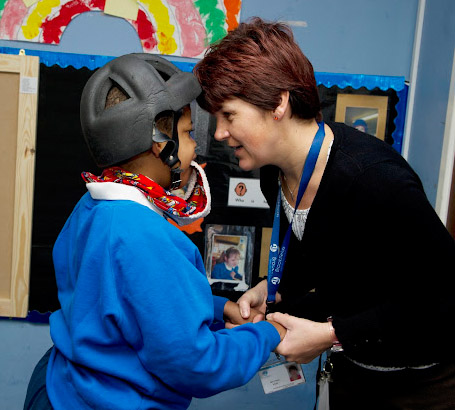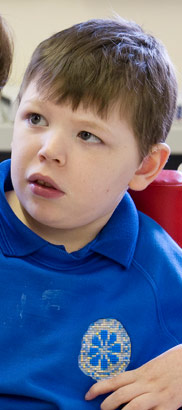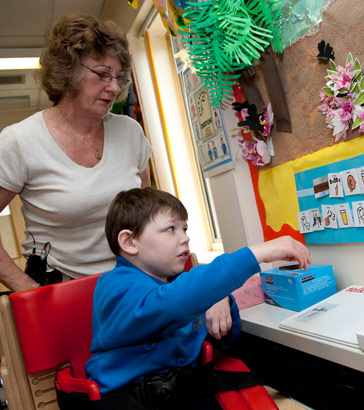
The development of social cognition depends on a number of factors, including:
- Typical pro-social skills development (eg gaze following, shared attention), sensory processing, etc;
- Sympathetic, responsive and consistent parenting;
- Rich communication experiences;
- Discussion of social experiences, especially within the family.
Children with SLD/PMLD/CLDD may experience a range of social and
emotional difficulties which will impact on their engagement in learning and interactions with others.

The following slides focus on a social emotional issue with autism as the focus disability. This disability was chosen as it often co-occurs in children with CLDD. Background information about the social emotional developmental area can be found at Level B.
If the basic processes important for the development of social cognition
are impaired, such as gaze-following and the ability to share attention,
then social cognition will be affected, as in autism spectrum disorders.
Goswami, 2008
Autism Spectrum Disorders (ASD)...share
core
impairments in reciprocal social interaction, communication and a pattern
of restricted/repetitive behaviours or interests. The most recent prevalence
estimates for
ASD range
from 1/1000 to 4/1000 for
narrowly-defined DSM-IV-TR autistic disorder
and from 6/1000 to 9/1000 for the broader category of ASD.
Johnson et al, 2010
Diagnosis of ASD is usually based on language delay (30-36 months).

If a child lacks the behaviours below, it suggests an immediate need for
autism screening:
- No babbling by 12 months.
- No gesturing (pointing, waving bye-bye, etc.) by 12 months.
- No single words by 16 months.
- No two-word spontaneous (not just echolalic) phrases by 24 months.
- Any loss of any language or social skills at any age.
Diagonistic options: a guide for professionals
a theory of mind

Baron-Cohen (1995) identifies the following key stages in development.
0-9 months
Intention Detection and Eye Direction Detection
Dyadic: caregiver/child
9-18 months
Shared Attention Mechanism
Triadic: caregiver/child/object, etc.
48 months
Emerging Theory of Mind
This may appear earlier (Goswami and Bryant, 2007).
Impairments in joint attention are specifically characteristic of young
children with ASD, relative to children with developmental delay or other
conditions.
Elsabbagh and Johnson, 2009
Goodhart and Baron-Cohen studied autistic children with mental ages ranging
from
1 to 7 years of age. Ninety percent of them used pointing as a nonverbal
naming activity, without eye contact, while looking at a picture book,
whereas only 25% of the group used pointing that was combined with eye
contact for joint activity.
Capone and McGregor, 2004
This document lists some early indications of autism.
Alcorn et al (2011) make the following observations:

- Typically developing individuals frequently initiate joint attention [co-ordination of attention on an object] for the purpose of social sharing, finding the reciprocal interest and affect strongly motivating.
- Joint attention... requires the ability to follow and direct another person's focus of attention... [indicated by] gaze direction or gesture.
- Individuals with ASD often show extreme difficulty with the gaze following and social inference necessary for successful joint attention.
- [Initiation of] joint attention is a key skill... its improvement seems to lead to lasting benefit in many areas, including language.

Interventions must be informed by effective assessment/functional analysis.
Existing and developing strategies include:
- Group social skills training
(Williams White et al, 2006) - Social stories
(Gray, 2010) - Teaching play
(Phillips and Beavan, 2012) - Child-led interaction
(eg Caldwell, 2010; Hewett et al, 2012;
Nind et al, 2001; Stephens, 2008)
- Sherborne Developmental Movement
(Konaka, 2007) - Emotion recognition coaching
(University of Cambridge, 2004) - ICT-supported
social problem-solving
(Alcorn et al, 2011; Bernard-Opitz et al, 2001) - Robots
(Dautenhahn and Werry, 2004)
Generalization and flexible skill use in natural environments continues
to be a challenge.
Williams White et al, 2006
Design a programme to extend that skill, and generalise it into other contexts.
How will you involve the child's family in identifying the target skill, programme design
and implementation?

Autistic Spectrum Disorders: Good practice guidance.
Annesley: Department for Education and Skills.
Beyer, J. and Gammeltoft, L. (1999) Autism and Play.
London: Jessica Kingsley.
Guralnick, M.J., Hammond, M.A. and Connor, R.T. (2006) Nonsocial play patterns of young children with communication disorders: implications for behavioral adaptation, Early Education and Development, 17 (2), 203-228.
Ingersoll, B.R. (2010) Teaching social communication: a comparison of naturalistic behavioural and development, social pragmatic approaches for children with autism spectrum disorders, Journal of Positive Interventions, 12 (1), 33-43.

Jordan, R. (2003) Social play and autistic spectrum disorders: a perspective
on theory, implications and educational approaches, Autism, 7, 347-360.
Morton, A.G., Stevenson, J.L., Khandakar, S. and Goldsmith, H.H. (2008)
Why does joint attention look atypical in autism?, Child Development
Perspectives, 2 (1), 38-45.
Ramachandran, V.S. and Lindsay, M.O. (2006) Broken mirrors: a theory of
autism,
Scientific American, 295 (5), 63-69.
Rizzolatti, G., Fogassi, L. and Gillese, V. (2006) Mirrors in the mind,
Scientific American, 295 (5), 54-61.

Thornton, K. and Taylor, E. (2007) An interactive approach supporting
behavioural and developmental growth. In: Carpenter, B. and Egerton, J.
(eds) New Horizons in Special Education: Evidence-based practice in action.
Clent: Sunfield Publications.
Trevarthen, C. (2011) What is it like to be a person who knows nothing?:
defining the active intersubjective mind of a newborn human being, Infant
and Child Development, 29, 119-135.
Visual Impairment and Autism Project (2011) Children who
Have Visual
Impairment and Autism: Identifying and sharing practice (Resource pack).
London: Royal National Institute of Blind People (RNIB).